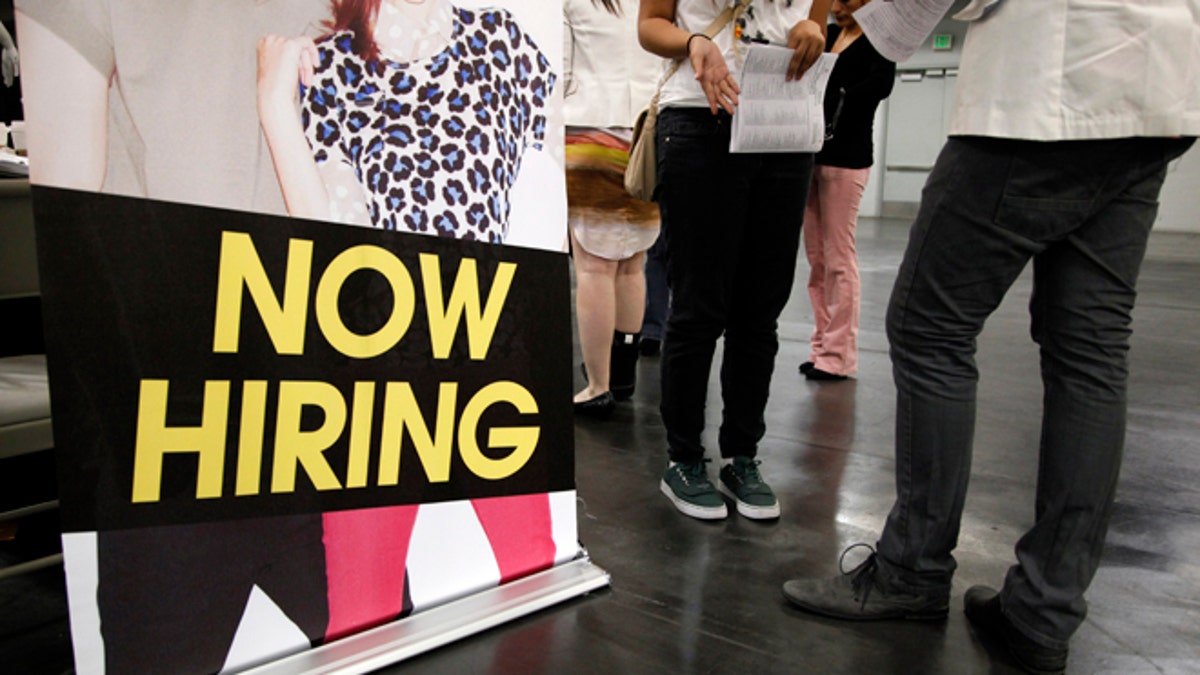
June 13, 2012: A job seeker talks to a recruiter at a job fair expo in Anaheim, Calif. (AP)
Friday, forecasters expect the Labor Department to report the economy added 113,000 jobs in September—a monthly pace too slow to return the nation to full employment.
The economy must add more than 375,000 jobs each month for three years to lower unemployment to 6 percent and that is not likely with current policies.
Most analysts see the unemployment rate steady at 8.1 percent, while a few see an increase. The wildcard is the number of adults actually working or seeking jobs—the measure of the labor force used to calculate the unemployment rate.
Were the labor force participation rate the same today as when unemployment peaked at 10 percent in October 2009, the unemployment rate would still be about 10 percent. Were it the same as when President Obama took office, it would be about 11 percent.
[pullquote]
Convincing millions more adults they don’t need or want a job has been the Obama administration’s most effective jobs program, despite trillions in new stimulus spending, industrial policies, targeted tax cuts, and social programs intended to boost demand.
In 2007, the last year before the financial collapse, the deficit was $161 billion with the Bush tax cuts in place and the United States fully engaged in Iraq and Afghanistan. Over the last four years, the deficit has averaged $1.3 trillion—additional targeted tax cuts, such as the $95 billion in reduced payroll taxes, and new government programs account for most of the rest.
Though Congress may avoid Sequestration, some temporary tax cuts, such as reduced social security taxes and elements of the Bush tax cuts benefiting high income families will likely lapse and some combination of savings in entitlements and defense spending will be accomplished. Overall, these would lower the deficit by something in the range of $300 billion.
If reelected, President Obama has promised some additional targeted stimulus spending—for example, to aid state budgets under the guise of teacher retention, infrastructure projects and additional industrial policies targeted at manufacturing in the alternative energy sector. When all the dust settles, the deficit will be left approximately where it is in 2012, and more fundamental problems holding back the U.S. economy will not have been addressed.
Economists agree that inadequate demand for what Americans make is holding back growth. During the early years of the recovery consumer demand did expand as the household deleveraging process ended; however, too many of those dollars were spent on imports that did not return to buy U.S. exports—the gap between new imports and new exports was lost demand for U.S. goods and services.
At nearly $600 billion, the trade deficit is almost entirely attributable to the gaps in trade with China and on oil, and it is the single most significant drag on demand, growth and jobs creation.
If elected, Governor Romney promises to tackle China’s undervalued currency and other mercantilist policies and open up offshore and Alaskan oil reserves for development. These polices could quickly boost demand by cutting the trade deficit in half, create 5 million jobs and get the economy growing again.
Longer term, policies proposed by Mr. Romney to lower the trade deficit could profoundly affect the pace of growth, because export and import-competing industries spend at least four times as much on R&D as does the private business sector as a whole.
Cutting the trade deficit in half could easily increase US R&D enough to boost US GDP growth by one or two percentage points. A US economy growing at 3 or 4 percent a year, instead of its current 2 percent, would have far more resources to address issues like health care, the solvency of social security, an adequate national defense, and space exploration.
Friday's jobs report will offer more than dry numbers. Rather, it will reveal much about the progress accomplished--and yet unrealized --toward rehabilitating the economy and creating jobs. With the right policies, the economy can create four or five hundred jobs a month, grow robustly and again offer Americans promising futures.
